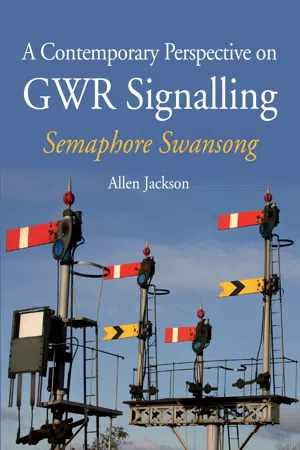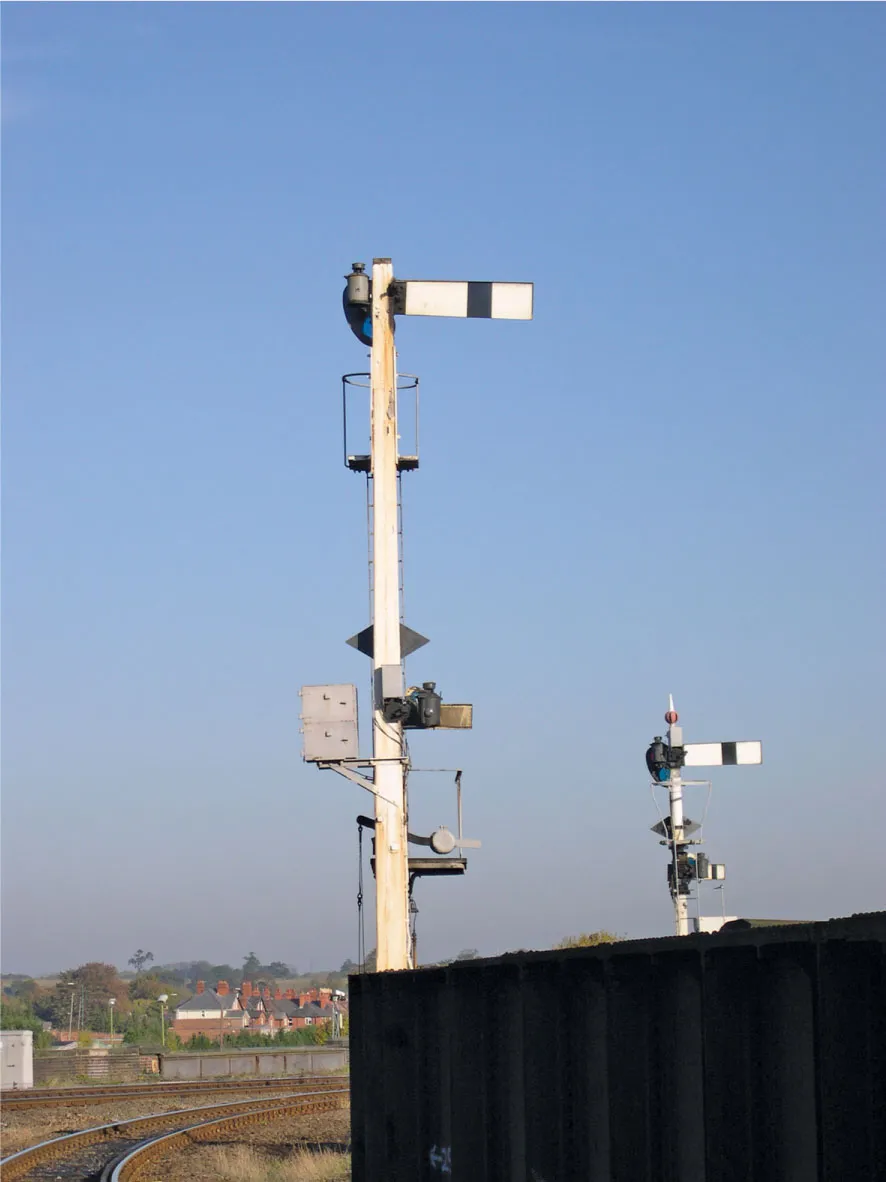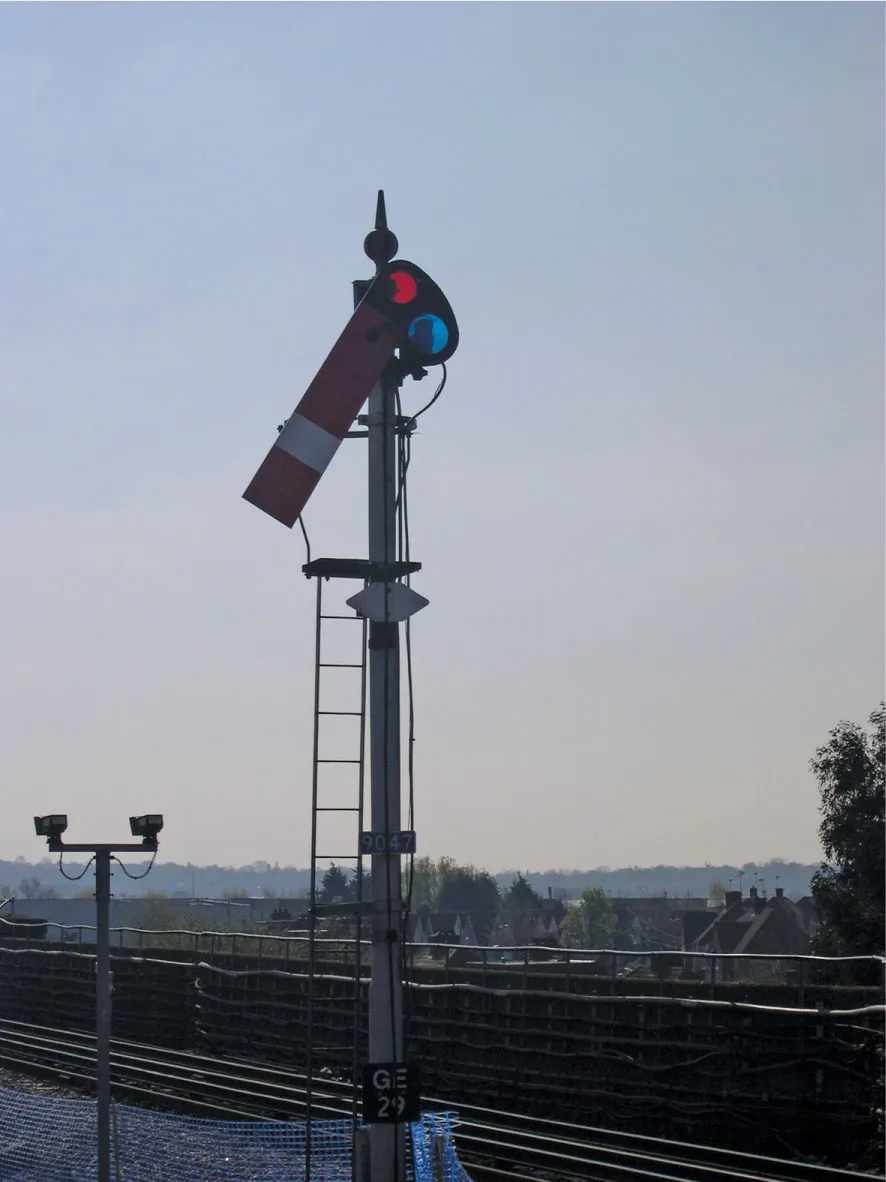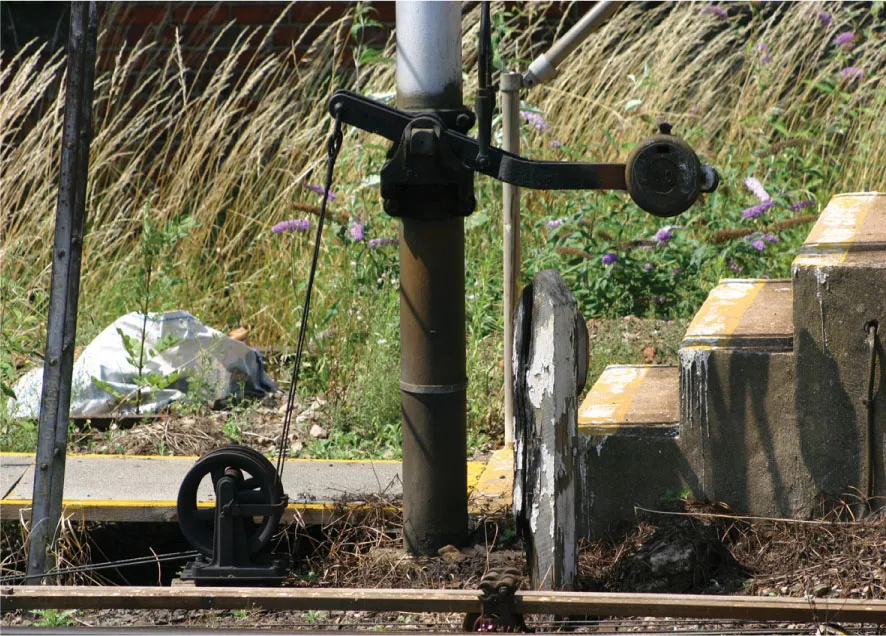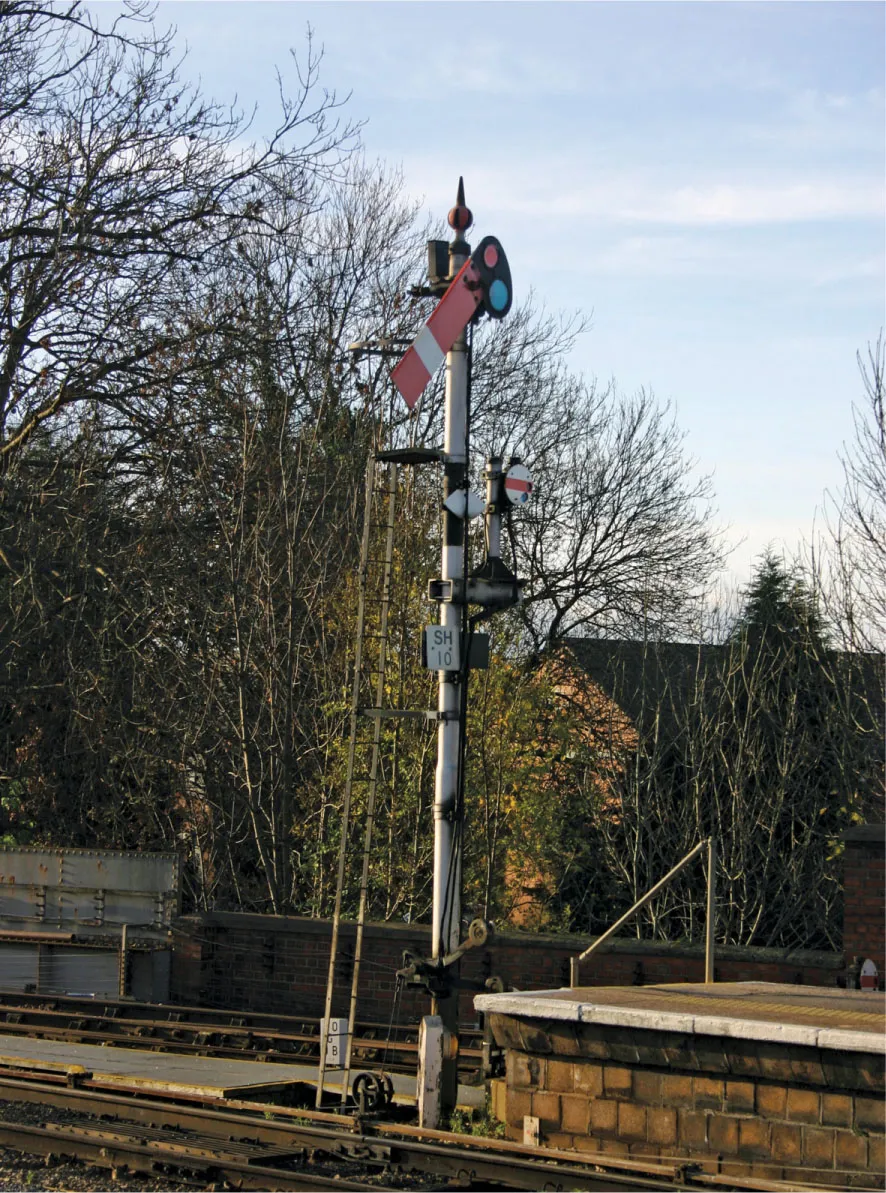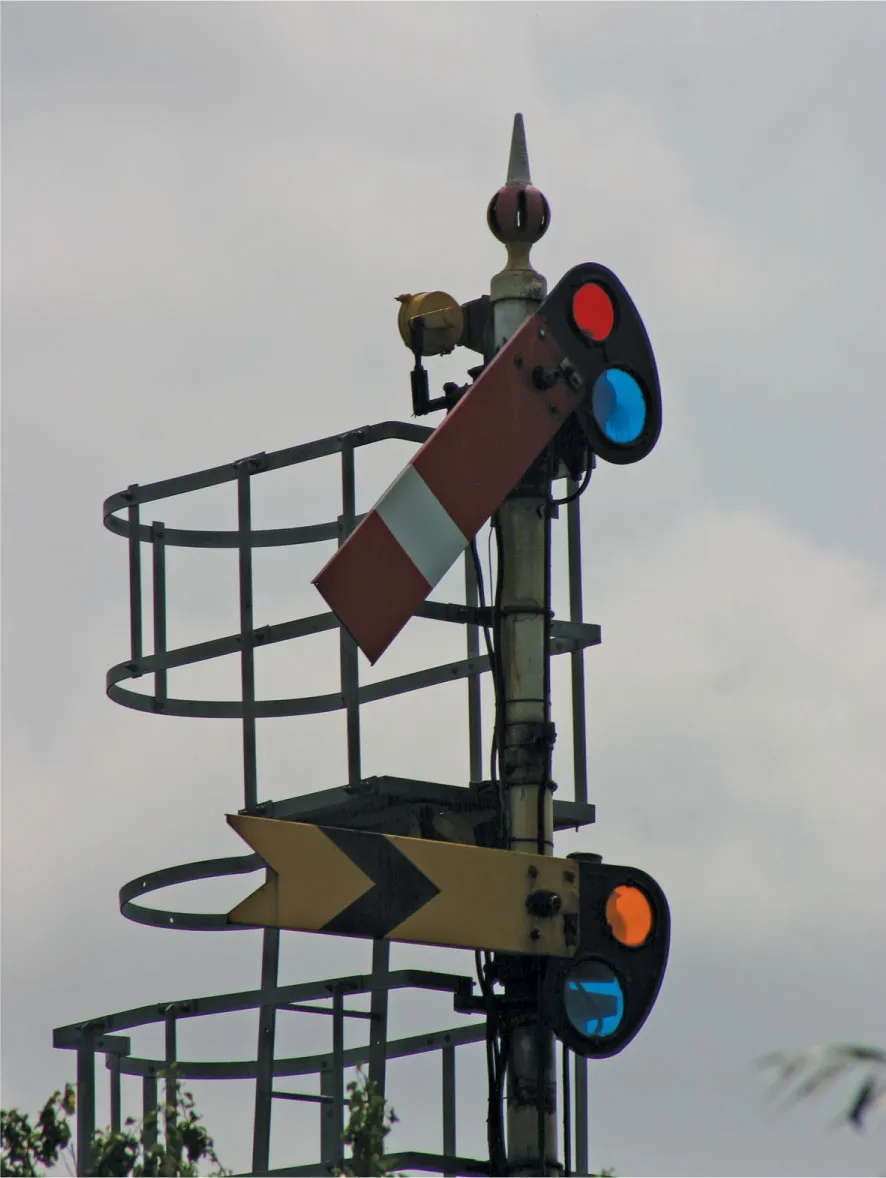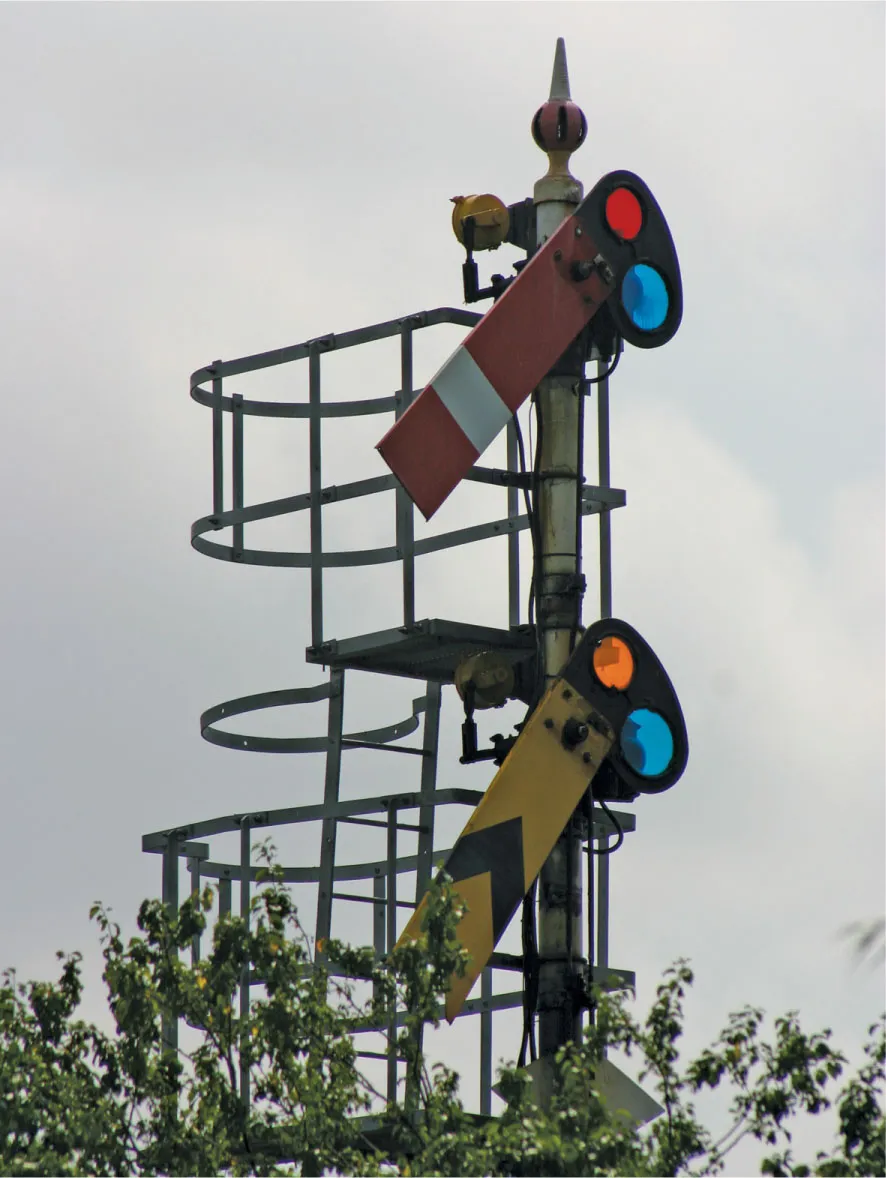![]()
CHAPTER 1
Lineside Signalling Equipment
Semaphore Signals
The Home Signal
The purpose of this signal could be described simply as stop or go. In the horizontal position the signal is said to be ON or stop. When the arm moves down from the horizontal by an angle of at least 60 degrees it is OFF or go.
The semaphore signal has evolved over time with operational experience and different materials used. Originally signal posts were made of wood, as were the arms. Posts since the 1940s are tubular steel and arms enamelled steel. The Western Region of British Railways continued with the steel style.
The oil lamp would originally be filled and trimmed every day, then later once a week and now they are electrically lit. The ladder was to allow access to the lamp and lens for cleaning. The post is finished off with a finial at the top, which apart from being decorative protects the timber post from the weather. Finials also appear on tubular post signals but more as decorative items.
The bottom few feet of the wooden post that is buried would be burned and charred to inhibit rot. Some wooden post signals survived into the 2000s so would have been at least sixty years old.
Fig. 3 The down platform starter at Carrog, Llangollen Railway, protecting the route to Corwen, April 2008.
The example of the wooden post signal in Fig. 3 is at Carrog on the Llangollen Railway, in April 2008. The tapered wooden post is a reproduction and the signal arm has a distinctive ‘swan neck’ shape around the lens casting. This is classic GWR of the 1920s and 1930s and now exists only on the preserved railway scene.
Fig. 4 One of the last wooden post GWR signals on Network Rail at Shrewsbury, October 2003.
Just about the last survivor of a wooden post GWR signal on Network Rail was at Shrewsbury, controlled by Crewe Junction signal box. It was still working in October 2003. It had lost its finial by this time and had replacement steel arms, as shown in Fig. 4.
Fig. 5 The ‘go’ condition displayed at Greenford East, London, April 2006.
Fig. 5 clearly illustrates a tubular post signal that is most definitely OFF or go. The lenses through which the lamp shines are red and blue as the original oil lamp would shine a yellow colour. When OFF the signal would then display a green light as required.
This is a cloistered enclave of semaphore signalling in west London which is surrounded by signalling modernity. Note the London Underground Limited (LUL) tube lines in the background. The rumblings of Crossrail are not far away.
Semaphore signals are usually operated by a series of wires and pulleys and bellcranks. A bellcrank is just a lever that lets a signal wire change direction and can amplify or diminish movement.
Fig. 6 The foot of a tubular steel signal post with the operating wires going round a pulley to operate the signal lever. There are two wires as there are two signals on this post. Worcester Shrub Hill station, July 2014.
A similar principle is employed with points. All the equipment is connected to a lever in a signal box or sometimes to levers by the lineside known as a ground frame. In Fig. 6 the lever has a counterbalance weight that can be slid up and down the lever and then locked when the optimum balance position has been found. The signal technician will need this facility to set the signals up initially.
Fig. 7 The complete signal at Worcester Shrub Hill station, July 2014.
The lever operates the ‘down rod’, the black rod going vertically upwards which operates the signal arm. If the wire breaks the signal will return to ON or stop and is therefore failsafe. Fig. 7 shows the complete signal at Worcester Shrub Hill station.
The action of a train driver who passes a signal at danger is referred to as a SPAD (signal passed at danger) and this can have dire consequences. The Paddington rail crash of October 1999 was a SPAD and the cost was thirty-one people killed and over 400 injured. It was subsequently decided that the signal involved was badly sighted. There is a section on signal sighting later on in the Introduction.
The Distant Signal
A train that is moving fast and is heavy to the tune of several hundred tons possesses momentum, and this means any change in speed can take a while to take effect. The media will often compare it to a supertanker ship.
The distant signal is placed before the home signal to warn the train driver that the next signal might say stop and the distance between the signals gives the driver time to bring the train to a stand if needed.
A distant signal in the ON or horizontal position means proceed with caution and be prepared to stop at the next home signal. OFF means the next home signal is also OFF. The distance between home and distant signals is often a function of the maximum line speed: the higher the speed, the greater the distance between distant and home signals. In confined station areas, where speeds are low, the distance can be much reduced. The distance between a distant and home signal is often several hundred yards.
The yellow fishtailed distant signal is now quite rare and most certainly an endangered species. It has been largely replaced by colour light signals even in areas where semaphore home signals are prevalent. Colour lights are much easier to see in foggy and low light conditions and are considered safer.
Fig. 8 A home and distant signal on one post. The home signal is saying proceed but the distant is saying proceed with caution and be prepared to stop at the next home signal. These signals are between Severn Bridge Junction and Sutton Bridge Junction Shrewsbury, July 2014.
In Fig. 8 the home signal is OFF but the distant is ON, meaning proceed past this signal but be prepared to stop at the next signal. This is a common means of slowing a train down when it is to take a slower line at the next junction signal. In this case the train is headed along the former Cambrian line, which is a slower-speed diverging route than straight on towards Hereford.
Fig. 9 The same home and distant signal on one post as in Fig. 8. The home signal and distant signals together indicate proceed and expect the next home signal to be also OFF, Shrewsbury, July 2014.
In Fig. 9 the train is obviously going down the Hereford line as both ‘boards’ are off. Note the modernized ladders and hoops on this Shrewsbury signal.
Some parts of the former GWR, Western Region British Railways, were hived off to other regions. Some of the area around Shrewsbury became London Midland Region from the 1960s and so other influences have been creeping in. Upper quadrant signals similar to ex-LMS designs are to be seen.
Fig. 10 Upper quadrant home and distant signals, with calling on arm below them on the same post at Sutton Bridge Junction Shrewsbury, July 2014.
The distant signal in Fig. 10 is an...
